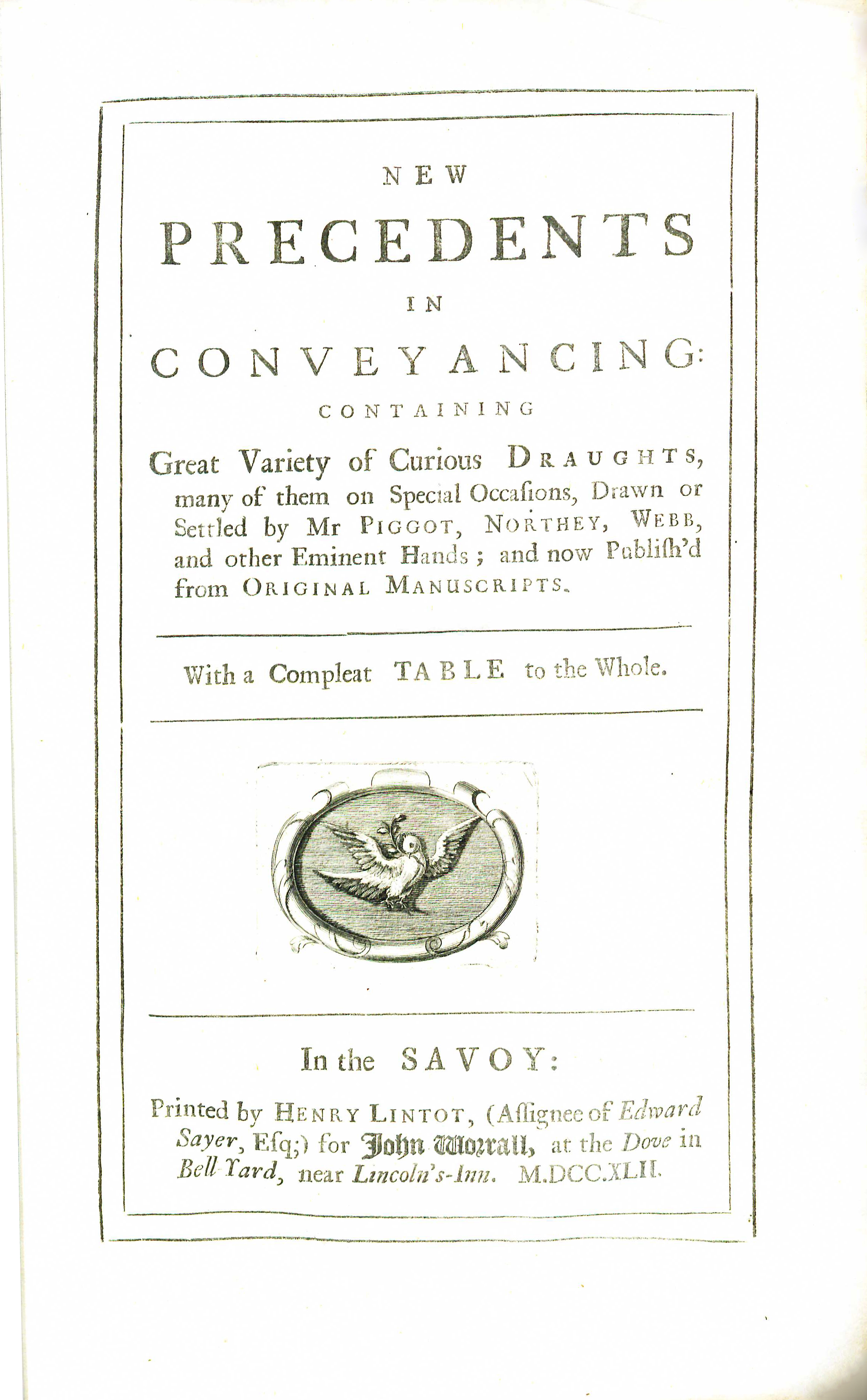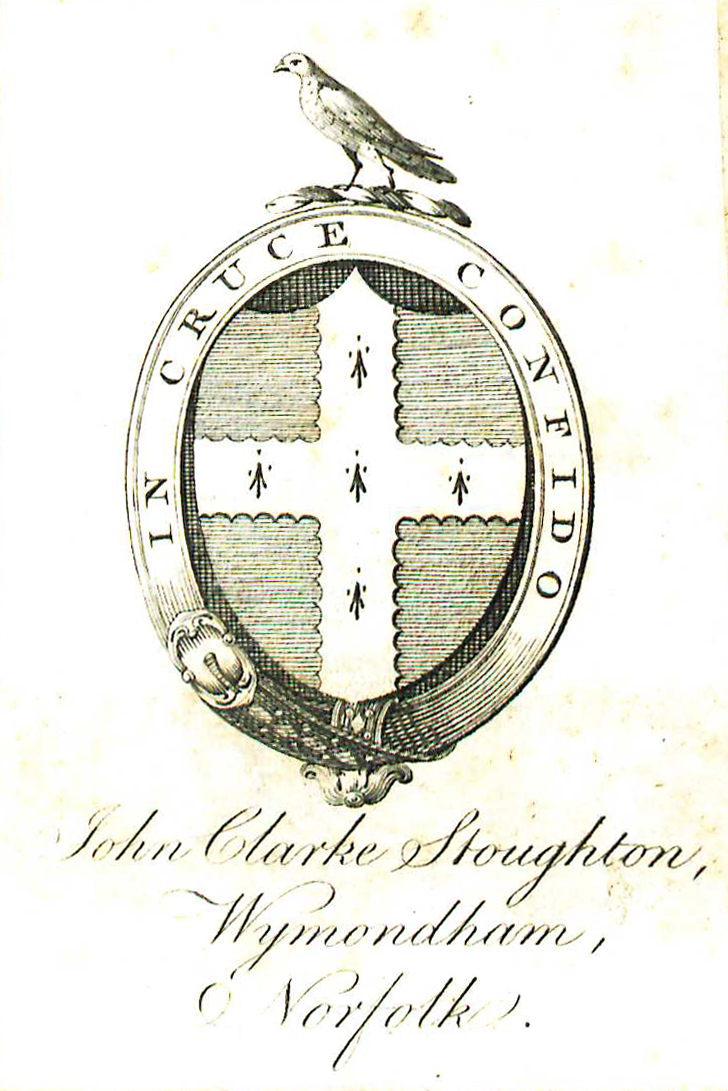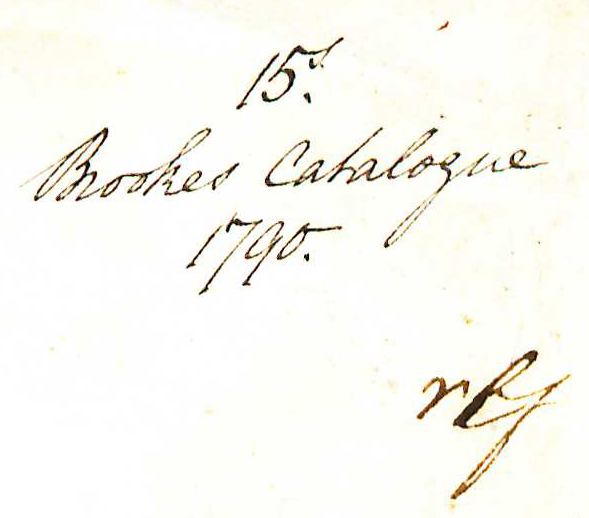Difference between revisions of "New Precedents in Conveyancing"
m (→Evidence for Inclusion in Wythe's Library) |
|||
| (11 intermediate revisions by 6 users not shown) | |||
| Line 4: | Line 4: | ||
{{BookPageInfoBox | {{BookPageInfoBox | ||
|imagename=PigottNewPrecedentsInConveyancing1742Titlepage.jpg | |imagename=PigottNewPrecedentsInConveyancing1742Titlepage.jpg | ||
| − | |link=https:// | + | |link=https://wm.primo.exlibrisgroup.com/permalink/01COWM_INST/g9pr7p/alma991031124509703196 |
|shorttitle=New Precedents in Conveyancing | |shorttitle=New Precedents in Conveyancing | ||
|commontitle=Pigott's Conveyancing | |commontitle=Pigott's Conveyancing | ||
| − | |author=Nathaniel Pigott | + | |author=[[:Category:Nathaniel Pigott|Nathaniel Pigott]] |
| − | |publoc=London | + | |publoc=[[:Category:London|London]] |
|publisher=Printed by H. Lintot for J. Worrall | |publisher=Printed by H. Lintot for J. Worrall | ||
|year=1742 | |year=1742 | ||
|edition=Second | |edition=Second | ||
| − | |lang=English | + | |lang=[[:Category:English|English]] |
|pages=iv, 576, [26] | |pages=iv, 576, [26] | ||
| − | |desc=Folio (31 cm.) | + | |desc=[[:Category:Folios|Folio]] (31 cm.) |
| − | }}{{BookPageBookplate | + | |shelf=L-5 |
| + | }}[http://en.wikipedia.org/wiki/Nathaniel_Pigott Nathaniel Pigott] (1661 – 1737) was a barrister and counselor at law. He was admitted to the [http://en.wikipedia.org/wiki/Inner_Temple Inner Temple] in 1683 and called to the bar in 1688.<ref>F. A. Inderwick, "Bench Table Orders," in ''A Calendar of the Inner Temple Records'' (London: Chiswick Press, 1901), 248.</ref> In 1689 he refused to take the required oaths of supremacy and allegiance and receive the sacrament.<ref>Richard G. Williams, "[http://www.oxforddnb.com/view/article/89542 Pigott, Nathaniel (bap. 1661, d. 1737)]" in ''Oxford Dictionary of National Biography'', accessed December 4, 2013.</ref> As a result, he was vacated on the grounds that he was a Roman Catholic.<ref>Ibid.</ref> In 1690 his suspension was removed although he was still prescribed from pleading a case in court.<ref>Ibid.</ref> Pigott was the last Catholic called to the bar until 1791.<ref>Ibid.</ref> | ||
| + | |||
| + | {{BookPageBookplate | ||
|imagename=PigottNewPrecedentsInConveyancing1742Bookplate.jpg | |imagename=PigottNewPrecedentsInConveyancing1742Bookplate.jpg | ||
|display=left | |display=left | ||
|caption=Bookplate of John Clarke Stoughton, Wymondham, Norfolk, front pastedown. | |caption=Bookplate of John Clarke Stoughton, Wymondham, Norfolk, front pastedown. | ||
| − | }} | + | }}Pigott practiced as a chamber counsel and conveyancer.<ref>Ibid.</ref> He acted as a trustee for conveyances, furnished legal opinions, and offered legal and business advice.2 Experts agree that Pigott had a particular expertise in conveyance.<ref>Ibid.</ref> Many of his clients were also Roman Catholics, therefore his expertise in conveyancing was particularly important to the preservation of their estates.<ref>Ibid.</ref> Roman Catholic estates were vulnerable to claims from potential protestant heirs and from threatened sequestrations by the crown.<ref>Ibid.</ref> |
| − | + | ||
| − | Pigott practiced as a chamber counsel and conveyancer.<ref>Ibid.</ref> He acted as a trustee for conveyances, furnished legal opinions, and offered legal and business advice.2 Experts agree that Pigott had a particular expertise in conveyance.<ref>Ibid.</ref> Many of his clients were also Roman Catholics, therefore his expertise in conveyancing was particularly important to the preservation of their estates.<ref>Ibid.</ref> Roman Catholic estates were vulnerable to claims from potential protestant heirs and from threatened sequestrations by the crown.<ref>Ibid.</ref | + | Two of Pigott's manuscripts, ''A Treatise of Common Recoveries, their Nature and Use'' and ''New Precedents in Conveyancing'', were published after his death.<ref>Ibid.</ref> These texts remained standard authorities for the remainder of the eighteenth century.<ref>Ibid.</ref> |
| − | |||
| − | Two of | ||
==Evidence for Inclusion in Wythe's Library== | ==Evidence for Inclusion in Wythe's Library== | ||
| − | There is no doubt that George Wythe owned this title—a copy of the second (1742) edition at the Library of Congress includes Wythe's bookplate and manuscript notes which may have been made by him.<ref>E. Millicent Sowerby, ''Catalogue of the Library of Thomas Jefferson'', | + | There is no doubt that George Wythe owned this title—a copy of the second (1742) edition at the Library of Congress includes Wythe's bookplate and manuscript notes which may have been made by him.<ref>E. Millicent Sowerby, ''Catalogue of the Library of Thomas Jefferson'', (Washington, D.C.: The Library of Congress, 1952-1959), 2:292 [[http://babel.hathitrust.org/cgi/pt?id=mdp.39015033648109;view=1up;seq=310 no.1940]].</ref> [[Thomas Jefferson]] listed "Pigott's conveyancing. fol." in his [[Jefferson Inventory|inventory]] of [[Wythe's Library]], noting that he kept the volume himself. He later sold it to the Library of Congress. Not surprisingly, all four of the [[George Wythe Collection|Wythe Collection]] sources (Goodwin's pamphlet<ref>Mary R. M. Goodwin, [https://research.colonialwilliamsburg.org/DigitalLibrary/view/index.cfm?doc=ResearchReports\RR0216.xml ''The George Wythe House: Its Furniture and Furnishings''] (Williamsburg, Virginia: Colonial Williamsburg Foundation Library, 1958), XLIX.</ref>, [[Dean Bibliography|Dean's Memo]]<ref>[[Dean Bibliography|Memorandum from Barbara C. Dean]], Colonial Williamsburg Found., to Mrs. Stiverson, Colonial Williamsburg Found. (June 16, 1975), 4 (on file at Wolf Law Library, College of William & Mary).</ref>, Brown's Bibliography<ref>Bennie Brown, "The Library of George Wythe of Williamsburg and Richmond," (unpublished manuscript, May, 2012) Microsoft Word file. Earlier edition available at: https://digitalarchive.wm.edu/handle/10288/13433.</ref> and [http://www.librarything.com/profile/GeorgeWythe George Wythe's Library]<ref>''LibraryThing'', s.v. "[http://www.librarything.com/profile/GeorgeWythe Member: George Wythe]," accessed on June 28, 2013.</ref> on LibraryThing) list the second edition of ''New Precedents in Conveyancing''. The Wolf Law Library purchased a copy of the same edition. |
| − | [[File:PigottNewPrecedentsInConveyancing1742Inscription.jpg| | + | [[File:PigottNewPrecedentsInConveyancing1742Inscription.jpg|right|thumb|300px|<center>Headpiece, first page of text.</center>]] |
| + | |||
==Description of the Wolf Law Library's copy== | ==Description of the Wolf Law Library's copy== | ||
Bound in contemporary calf with blind rules to boards, raised bands and lettering piece to spine. Includes armorial bookplate of John Clarke Stoughton, Wymondham, Norfolk on front pastedown and an early owner annotation, "15<sup>s</sup> Brookes Catalogue 1790", and the intials "rlf" on front free endpaper. Purchased from The Lawbook Exchange, Ltd. | Bound in contemporary calf with blind rules to boards, raised bands and lettering piece to spine. Includes armorial bookplate of John Clarke Stoughton, Wymondham, Norfolk on front pastedown and an early owner annotation, "15<sup>s</sup> Brookes Catalogue 1790", and the intials "rlf" on front free endpaper. Purchased from The Lawbook Exchange, Ltd. | ||
| − | View the record for this book in [https:// | + | Images of the library's copy of this book are [https://www.flickr.com/photos/wolflawlibrary/sets/72157660123001872 available on Flickr.] View the record for this book in [https://wm.primo.exlibrisgroup.com/permalink/01COWM_INST/g9pr7p/alma991031124509703196 William & Mary's online catalog.] |
| + | |||
| + | ===Full text=== | ||
| + | <div style="overflow: hidden;"> | ||
| + | *[http://lawlibrary.wm.edu/wythepedia/library/PigottNewPrecedentsInConveyancing1742.pdf ''New Precedents in Conveyancing''] (31MB PDF) | ||
| + | </div> | ||
| + | |||
| + | ==See also== | ||
| + | *[[George Wythe Room]] | ||
| + | *[[Jefferson Inventory]] | ||
| + | *[[Wythe's Library]] | ||
| + | |||
==References== | ==References== | ||
<references/> | <references/> | ||
| + | |||
| + | ==External links== | ||
| + | *Read this book at the [https://archive.org/details/newprecedentsinc00adam Internet Archive.] | ||
[[Category:Commercial Law]] | [[Category:Commercial Law]] | ||
[[Category:George Wythe Collection at William & Mary's Wolf Law Library]] | [[Category:George Wythe Collection at William & Mary's Wolf Law Library]] | ||
| + | [[Category: Jefferson's Books]] | ||
[[Category:Known Surviving Wythe Volumes]] | [[Category:Known Surviving Wythe Volumes]] | ||
| + | [[Category:Nathaniel Pigott]] | ||
[[Category:Titles in Wythe's Library]] | [[Category:Titles in Wythe's Library]] | ||
| + | |||
| + | [[Category:English]] | ||
| + | [[Category:Folios]] | ||
| + | [[Category:London]] | ||
Latest revision as of 11:22, 11 July 2023
by Nathaniel Pigott
| Pigott's Conveyancing | |
|
Title page from New Precedents in Conveyancing, George Wythe Collection, Wolf Law Library, College of William & Mary. | |
| Author | Nathaniel Pigott |
| Published | London: Printed by H. Lintot for J. Worrall |
| Date | 1742 |
| Edition | Second |
| Language | English |
| Pages | iv, 576, [26] |
| Desc. | Folio (31 cm.) |
| Location | Shelf L-5 |
Nathaniel Pigott (1661 – 1737) was a barrister and counselor at law. He was admitted to the Inner Temple in 1683 and called to the bar in 1688.[1] In 1689 he refused to take the required oaths of supremacy and allegiance and receive the sacrament.[2] As a result, he was vacated on the grounds that he was a Roman Catholic.[3] In 1690 his suspension was removed although he was still prescribed from pleading a case in court.[4] Pigott was the last Catholic called to the bar until 1791.[5]
Pigott practiced as a chamber counsel and conveyancer.[6] He acted as a trustee for conveyances, furnished legal opinions, and offered legal and business advice.2 Experts agree that Pigott had a particular expertise in conveyance.[7] Many of his clients were also Roman Catholics, therefore his expertise in conveyancing was particularly important to the preservation of their estates.[8] Roman Catholic estates were vulnerable to claims from potential protestant heirs and from threatened sequestrations by the crown.[9]
Two of Pigott's manuscripts, A Treatise of Common Recoveries, their Nature and Use and New Precedents in Conveyancing, were published after his death.[10] These texts remained standard authorities for the remainder of the eighteenth century.[11]
Evidence for Inclusion in Wythe's Library
There is no doubt that George Wythe owned this title—a copy of the second (1742) edition at the Library of Congress includes Wythe's bookplate and manuscript notes which may have been made by him.[12] Thomas Jefferson listed "Pigott's conveyancing. fol." in his inventory of Wythe's Library, noting that he kept the volume himself. He later sold it to the Library of Congress. Not surprisingly, all four of the Wythe Collection sources (Goodwin's pamphlet[13], Dean's Memo[14], Brown's Bibliography[15] and George Wythe's Library[16] on LibraryThing) list the second edition of New Precedents in Conveyancing. The Wolf Law Library purchased a copy of the same edition.
Description of the Wolf Law Library's copy
Bound in contemporary calf with blind rules to boards, raised bands and lettering piece to spine. Includes armorial bookplate of John Clarke Stoughton, Wymondham, Norfolk on front pastedown and an early owner annotation, "15s Brookes Catalogue 1790", and the intials "rlf" on front free endpaper. Purchased from The Lawbook Exchange, Ltd.
Images of the library's copy of this book are available on Flickr. View the record for this book in William & Mary's online catalog.
Full text
See also
References
- ↑ F. A. Inderwick, "Bench Table Orders," in A Calendar of the Inner Temple Records (London: Chiswick Press, 1901), 248.
- ↑ Richard G. Williams, "Pigott, Nathaniel (bap. 1661, d. 1737)" in Oxford Dictionary of National Biography, accessed December 4, 2013.
- ↑ Ibid.
- ↑ Ibid.
- ↑ Ibid.
- ↑ Ibid.
- ↑ Ibid.
- ↑ Ibid.
- ↑ Ibid.
- ↑ Ibid.
- ↑ Ibid.
- ↑ E. Millicent Sowerby, Catalogue of the Library of Thomas Jefferson, (Washington, D.C.: The Library of Congress, 1952-1959), 2:292 [no.1940].
- ↑ Mary R. M. Goodwin, The George Wythe House: Its Furniture and Furnishings (Williamsburg, Virginia: Colonial Williamsburg Foundation Library, 1958), XLIX.
- ↑ Memorandum from Barbara C. Dean, Colonial Williamsburg Found., to Mrs. Stiverson, Colonial Williamsburg Found. (June 16, 1975), 4 (on file at Wolf Law Library, College of William & Mary).
- ↑ Bennie Brown, "The Library of George Wythe of Williamsburg and Richmond," (unpublished manuscript, May, 2012) Microsoft Word file. Earlier edition available at: https://digitalarchive.wm.edu/handle/10288/13433.
- ↑ LibraryThing, s.v. "Member: George Wythe," accessed on June 28, 2013.
External links
- Read this book at the Internet Archive.


